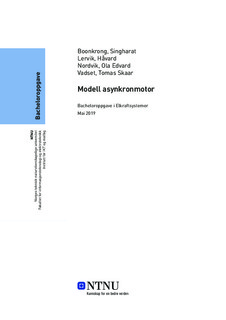Modell asynkronmotor
Bachelor thesis
Permanent lenke
http://hdl.handle.net/11250/2610900Utgivelsesdato
2019Metadata
Vis full innførselSamlinger
Sammendrag
Formålet med denne oppgaven var å utvikle en modell for en asynkronmotor. Denne modellen skal gjøre det mulig for STADT AS å gjøre simuleringer for motorer, slik at de blant annet kan se hvor store startstrømmene vil bli når de kobler en motor inn på nettet. Gruppen valgte å lage modellen i Simulink som er en utvidelse av MATLAB. Det ble oppdaget begrensinger på modellen når det kom til omkobling. Derfor ble det også laget en modell ved hjelp av Simscape for å gjøre opp for disse begrensingene. For å sjekke det optimale omkoblingstidspunktet, overvåket gruppen spenningen og fasevinkelen på begge sider av bryteren. Simscapemodellen blei også brukt til verifisering av modellen laget med grunnpakken i Simulink. Begge modellene har begrensninger, og krever videreutvikling før modellen kan brukes av oppdragsgiveren. The objective of this thesis was to develop a model for an induction motor. This model can be used by STADT AS to simulate transient responses of a motor, such as the magnitude of the starting currents when the motor is connected to the grid. The group chose to make the model in Simulink, which is an extension of MATLAB. The model is not without its limitations, which were discovered during the simulation phase of the project. Therefore, a model in Simscape was made to make up for these limitations. To find the optimal switchover time, the group monitored the voltage and phase-angle on both sides of the switch. The Simscape model was also used to verify the model made with the basic package in Simulink. Both models have limitations, and need further development before STADT can use them.
